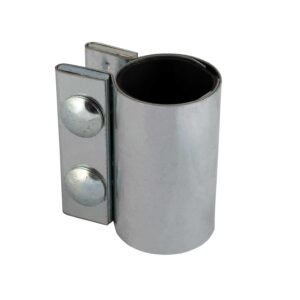Choosing the right type of connection for your pneumatic conveying system is crucially important. This article will cover the three most common types of pneumatic connections, including compression couplings, flanges, and Victaulic grooved ends. We’ll discuss the differences between them, as well as their pros and cons, and give insight on what to consider when selecting connections for your pneumatic conveying system.
What Are Connections?
In general, connections are used to join two shafts together in order to facilitate power transmission and axial movement, while compensating for a degree of misalignment. In pneumatic conveying, connections are used to join lengths of pipe or tube in order to close the line and keep the system pressurized.
Connections are essential to pneumatic conveying pipes, which must carry the product through the system safely and efficiently. To achieve this, pipes must be sealed properly. Connections in pneumatic conveying systems provide a tight seal between joints to prevent air leaks from occurring at pipe joints, a common issue that can lead to pressure drops, decreased productivity, and expensive repairs.
3 Common Types of Connections in Pneumatic Conveying Systems
Compression Couplings
Compression couplings are ideal for pneumatic conveying systems because their band type construction maintains uniform pressure across the entire surface of the joint. These can feature a sideband for systems that have higher operating pressures or where vibration is a concern.
A static conductive grounding strip is also a common feature in compression couplings, and is used to prevent the build-up of static electricity caused by particles colliding with pipe walls. These connections also don’t require a threaded pipe, and are less sensitive to pipe alignment.
The disadvantages of compression couplings is that they’re difficult and time consuming to dismantle. This also makes them awkward to adjust, so care must be taken when installing these into your pneumatic conveying system.
Flanges
Flanges are a type of connection that feature a protruding ridge. This serves three main purposes: it strengthens the joint, makes attachment easier, and stabilizes the movements of equipment and components. Flanges are typically bolted in place, with a gasket slotted between the two pieces in order to provide a tight seal.
The tight connection that flanges provide makes them ideal for pneumatic conveying systems that operate under high pressures, or have pipelines that travel over long distances.
However, flanged connections are even harder to dismantle than compression connections, and are also difficult to adjust. Additionally, because they rely on a gasket to provide the seal, they require the gasket to be changed at each opening.
Victaulic Grooved Ends
Also known as mechanical grooved couplings, Victaulic grooved ends consist of a rubber gasket within a metal connection housing. Unlike a standard compression joint that simply relies on pressure as a sealant, Victaulic grooved ends use the compressive force around the gasket lips to create a pressure responsive seal around the pipe exterior.
Using a pressure responsive seal means Victaulic grooved ends don’t require welding, flanging, or threading to connect pipes. This reduces time and labor in both manufacturing and system assembly.
But Victaulic grooved ends aren’t suitable for every system. As a branded component, they’re exclusively designed to fit other Victaulic connections, pipes, valves, and accessories, and are unsuitable for piping systems with plain-end connections. While this provides Victaulic piping systems with a certain consistency and reliability, it makes incorporating Victaulic grooved ends difficult for conveying systems that lack the corresponding parts.
How to Choose the Right Connections
Ensuring you use the right type of connection for your specific system is crucially important if you want to maximize operational efficiency and extend the lifespan of your equipment.
For example, if your system is used to convey bulk materials that are prone to blocking, you’ll want a connection that’s quick and easy to dismantle. You should also consider the typical pressure values in your system and how these affect your connections. Connections in pneumatic conveying systems that have high pressure values must provide a robust seal that mitigates axial stresses while strengthening the joints.
Connections come in a range of materials and sizes, the choice of which will depend on the specifics of your system and the products it carries. In general, stainless steel connections have excellent chemical resistance and tend to be the most durable. Meanwhile, galvanized steel is a cheaper option that is well suited for the conveying of dry bulk materials.
At PneuComponents, we supply a range of components for your pneumatic conveying system, from compression connections, elbows, and line fittings, to diverters, lump breakers, and airlocks. View our range of products here or contact us to see how we can help with your specific needs.
As a part of Progressive Products, Inc, PneuComponents draws on over 40 years of technical expertise and industry innovation to give you the best possible guidance and service. Progressive Products is an industry-leading manufacturer of abrasion-resistant components, and their products are used in pneumatic conveying systems worldwide.
-
CouplingsPrice range: $12.03 through $48.28

